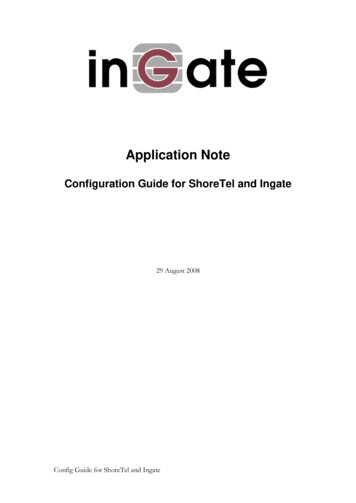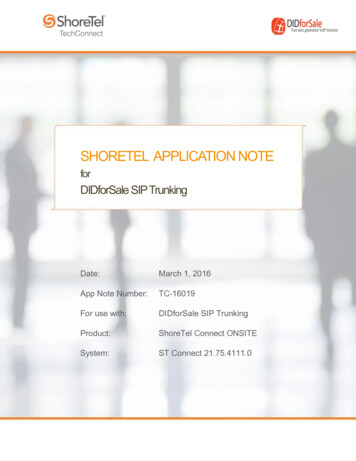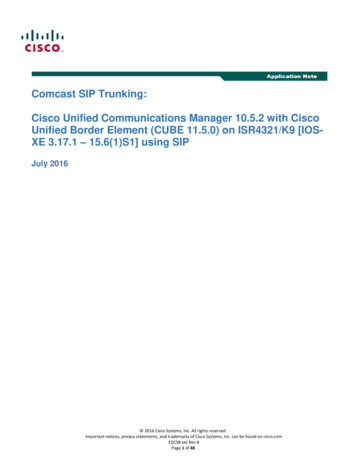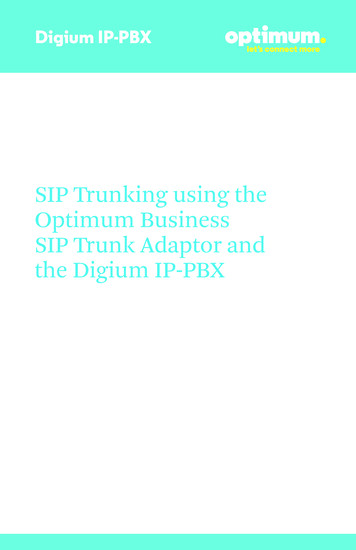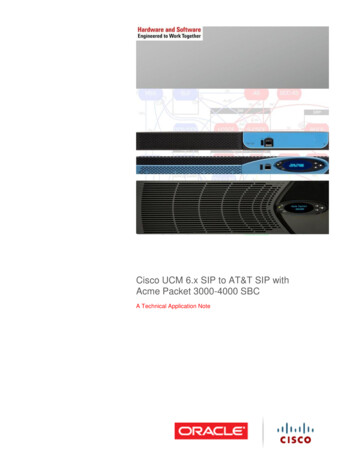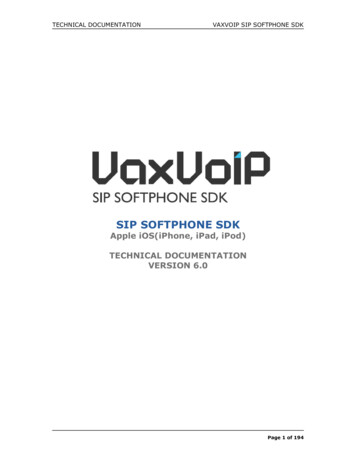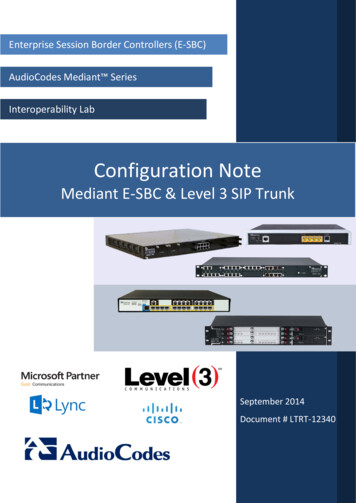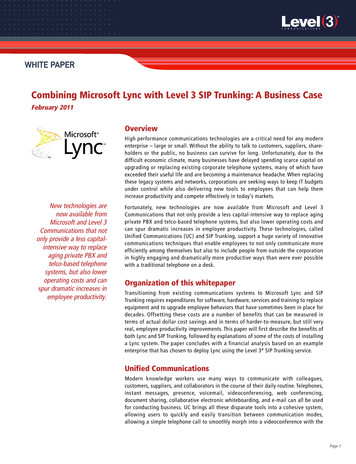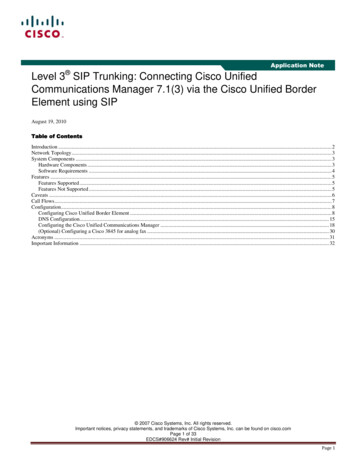
Transcription
Application NoteLevel 3 SIP Trunking: Connecting Cisco UnifiedCommunications Manager 7.1(3) via the Cisco Unified BorderElement using SIPAugust 19, 2010Table of ContentsIntroduction . 2Network Topology . 3System Components . 3Hardware Components . 3Software Requirements . 4Features . 5Features Supported . 5Features Not Supported . 5Caveats . 6Call Flows. 7Configuration . 8Configuring Cisco Unified Border Element . 8DNS Configuration. 15Configuring the Cisco Unified Communications Manager . 18(Optional) Configuring a Cisco 3845 for analog fax . 30Acronyms . 31Important Information . 32 2007 Cisco Systems, Inc. All rights reserved.Important notices, privacy statements, and trademarks of Cisco Systems, Inc. can be found on cisco.comPage 1 of 33EDCS#906624 Rev# Initial RevisionPage 1
IntroductionService Providers today, such as Level 3 Communications, are offering alternative methods to connect to the PSTN via their IP network. Mostof these services utilize SIP as the primary signaling method and a centralized IP to TDM gateway to provide on-net and off-net services. Level3 SIP Trunking is a service provider offering that allows connection to the PSTN and may offer the end customer a viable alternative totraditional PSTN connectivity via either Analog or T1 lines. A demarcation device between these services and customer owned services isrecommended. The Cisco Unified Border Element provides demarcation, security, interworking and session management services.This application note describes how to configure a Cisco Unified Communications Manager (Cisco UCM) 7.1(3) with a Cisco UnifiedBorder Element (Cisco UBE) for connectivity to the Level 3 SIP Trunking service. The deployment model covered in this applicationnote is CPE (Cisco UCM 7.1(3)/Cisco UBE) to PSTN via Level 3 SIP Trunking. This document does not address 911 emergencyoutbound calls. For 911 feature service details contact Level 3 Communications, directly.Testing was performed in accordance to Cisco’s Service Provider SIP Trunk Validation Test Plan and all features were verified. Keyfeatures verified are:Basic CallsBasic Calls with Calling Name and Number as allowed or restrictedDTMF RelayCall Conference (Intra-site, PSTN)Call Transfer (Blind, Attended, Early Attended)Hold and ResumeVoice MailT.38 Fax G3/SG3Simultaneous CallsAuto AttendantInternational CallsG.711 Fax G3/SG3Call Forwarding – Find Me (Unconditional, Busy, No Reply)Codec negotiationDial PlansPRACK with SDP early-media cut-throughThe Cisco Unified Border Element configuration detailed in this document is based on a lab environment with a simple dial-plan used toensure proper interoperability between Level 3 Communications’ SIP network and Cisco Unified Communications. The configurationdescribed in this document details the important commands to have enabled for interoperability to be successful and care must be taken,by the network administrator deploying Cisco UBE, to ensure these commands are set per each dial-peer requiring to interoperate toLevel 3 Communications’ SIP network.This application note does not cover the use of calling search spaces (CSS) or partitions on Cisco Unified Communications Manager. Tounderstand and learn how to apply CSS and partitions refer to the cisco.com link e ip comm/cucm/admin/8 0 2/ccmsys/a03ptcss.html 2010 Cisco Systems, Inc. All rights reserved.Important notices, privacy statements, and trademarks of Cisco Systems, Inc. can be found on cisco.comPage 2 of 33EDCS#906624 Rev # Initial RevisionNote:Testing was conducted at tekVizion Labs .
Network TopologyFigure 1. Lab Network TopologySystem ComponentsHardware ComponentsCisco 2811 (used as Cisco Unified Border Element)Cisco 3845 with VIC-4FXS/DID (used only for analog fax)Cisco Unified Communications Manager (3-node cluster consisting of Cisco MCS 7800 Series servers)Cisco IP Phones 2010 Cisco Systems, Inc. All rights reserved.Important notices, privacy statements, and trademarks of Cisco Systems, Inc. can be found on cisco.comPage 3 of 33EDCS#906624 Rev # Initial RevisionNote:Testing was conducted at tekVizion Labs .
Software RequirementsCisco Unified Communications Manager 7.1.3.20000-2Cisco Unified Border Element, IOS version 12.4(20)T4 (C2800NM-ADVENTERPRISEK9 IVS-M) 2010 Cisco Systems, Inc. All rights reserved.Important notices, privacy statements, and trademarks of Cisco Systems, Inc. can be found on cisco.comPage 4 of 33EDCS#906624 Rev # Initial RevisionNote:Testing was conducted at tekVizion Labs .
FeaturesFeatures SupportedVoice calls using G.729 and G.711 codecsRFC 3261 supportEarly media cut-through with DTMF relay before 200 OKCalling number presentation / restrictionCall conferencingCall transfer (attended and unattended)Call hold and resumeCall forwardingDTMF relay (RFC 2833)T.38 faxG.711 pass-through faxFeatures Not SupportedCaller ID update via SIP UDATE method 2010 Cisco Systems, Inc. All rights reserved.Important notices, privacy statements, and trademarks of Cisco Systems, Inc. can be found on cisco.comPage 5 of 33EDCS#906624 Rev # Initial RevisionNote:Testing was conducted at tekVizion Labs .
CaveatsAlthough Level 3 SIP Trunking supports the G.729 compressed codec, the service always offers G.711 as the preferred codec for PSTNto CPE calls.When a PSTN to CPE call is transferred by the CPE to a second PSTN number, the Caller ID displayed on the transfer target is the CPEDID number. It does not update to the original PSTN calling party number when the transfer is completed. 2010 Cisco Systems, Inc. All rights reserved.Important notices, privacy statements, and trademarks of Cisco Systems, Inc. can be found on cisco.comPage 6 of 33EDCS#906624 Rev # Initial RevisionNote:Testing was conducted at tekVizion Labs .
Call FlowsIn the sample configuration presented here, CUCM is provisioned with four-digit directory numbers corresponding to the last four DID digits.No digit manipulation is performed on the CUBE.For incoming PSTN calls, the CUBE presents the full ten-digit DID number to CUCM. The CUCM trunk configuration strips all but the lastfour digits and routes the call based on those digits. Voice calls are routed to IP phones; fax calls are routed via a 4-digit route pattern to a SIPtrunk that terminates on the router hosting the analog fax endpoint.CPE callers make outbound PSTN calls by dialing a “9” prefix followed by the destination number. For outbound fax calls from the analog faxendpoint, the router hosting that endpoint delivers all digits including the “9” prefix. A “9.@” route pattern strips the prefix and routes the callwith the remaining digits via a SIP trunk terminating on the CUBE.Figure 2. Outbound Voice CallFigure 3. Inbound Voice CallFigure 4. Outbound fax callFigure 5. Inbound fax call 2010 Cisco Systems, Inc. All rights reserved.Important notices, privacy statements, and trademarks of Cisco Systems, Inc. can be found on cisco.comPage 7 of 33EDCS#906624 Rev # Initial RevisionNote:Testing was conducted at tekVizion Labs .
ConfigurationConfiguring Cisco Unified Border ElementCritical commands are marked in Bold with footnotes at the bottom of the pageVersion Information:Cisco IOS Software, 2800 Software (C2800NM-ADVENTERPRISEK9 IVS-M), Version 12.4(20)T4,RELEASE SOFTWARE (fc4)Technical Support: http://www.cisco.com/techsupportCopyright (c) 1986-2009 by Cisco Systems, Inc.Compiled Tue 01-Sep-09 16:06 by prod rel teamROM: System Bootstrap, Version 12.4(13r)T5, RELEASE SOFTWARE (fc1)Main2811 uptime is 1 day, 9 hours, 10 minutesSystem returned to ROM by power-onSystem image file is "flash:c2800nm-adventerprisek9 ivs-mz.124-20.T4.bin"This product contains cryptographic features and is subject to UnitedStates and local country laws governing import, export, transfer anduse. Delivery of Cisco cryptographic products does not implythird-party authority to import, export, distribute or use encryption.Importers, exporters, distributors and users are responsible forcompliance with U.S. and local country laws. By using this product youagree to comply with applicable laws and regulations. If you are unableto comply with U.S. and local laws, return this product immediately.A summary of U.S. laws governing Cisco cryptographic products may be found rg.htmlIf you require further assistance please contact us by sending email toexport@cisco.com.Cisco 2811 (revision 53.51) with 245760K/16384K bytes of memory.Processor board ID FHK0923F0YT2 FastEthernet interfaces1 Serial interface1 Virtual Private Network (VPN) Module4 Voice FXS interfacesDRAM configuration is 64 bits wide with parity enabled.239K bytes of non-volatile configuration memory.62720K bytes of ATA CompactFlash (Read/Write)Configuration register is 0x2102Running Configuration:version 12.4 2010 Cisco Systems, Inc. All rights reserved.Important notices, privacy statements, and trademarks of Cisco Systems, Inc. can be found on cisco.comPage 8 of 33EDCS#906624 Rev # Initial RevisionNote:Testing was conducted at tekVizion Labs .
service timestamps debug datetime msecservice timestamps log datetime msecno service password-encryption!hostname Main2811!boot-start-markerboot system flash c2800nm-adventerprisek9 ivs-mz.124-20.T4.binboot-end-marker!logging message-counter sysloglogging buffered 51200 warningsno logging consoleenable secret 5 1 ELsJ rMOpADTplX/DtwNNBHvhY0!aaa new-model!!!!aaa session-id commonclock timezone CST -6clock summer-time CDT recurringno network-clock-participate slot 1!voice-card 0no dspfarm!voice-card 1dspfarmdsp services dspfarm!dot11 syslogip source-route!!ip cef!!ip domain name lab.tekvizion.com1ip name-server 10.64.1.32no ipv6 cef!multilink bundle-name authenticated!!!Optional, for use with a multiple-subscriber cluster. The domain name must match the CUCM enterprise parameter “ClusterFully Qualified Domain Name” and must resolve to a DNS SRV. See “DNS Configuration” and “CUCM Configuration” below.2IP address of DNS server1 2010 Cisco Systems, Inc. All rights reserved.Important notices, privacy statements, and trademarks of Cisco Systems, Inc. can be found on cisco.comPage 9 of 33EDCS#906624 Rev # Initial RevisionNote:Testing was conducted at tekVizion Labs .
!voice rtp send-recv3!voice service voipallow-connections sip to sip4fax protocol t38 ls-redundancy 0 hs-redundancy 0 fallback pass-through g711ulaw5siprel1xx disable6header-passing error-passthru7early-offer forced8midcall-signaling passthru9sip-profiles 10010!!!voice class codec 111codec preference 1 g711ulawcodec preference 2 g711alawcodec preference 3 g729r8!!!!voice class sip-profiles 10012response ANY sdp-header Audio-Attribute modify "sendonly" "sendrecv"request ANY sdp-header Audio-Attribute modify "sendonly" "sendrecv"!!!!!!!!!!!3Establish a 2-way voice path when a Real Time Protocol channel is openedAllow SIP to SIP call processing5Enable T.38 fax relay. Remaining parameters are optional; this example disables redundancy for both low-speed T.30 messagingand high-speed page data, and enables G.711 fallback if T.38 negotiation fails.6Level 3 does not support 100rel7Enable passing of unknown error responses8Configures CUBE to send a SIP INVITE with SDP on an outbound call leg (Delayed Offer to Early Offer)9Enable support for SIP re-INVITE supplementary services10Use “voice class sip-profiles 100” defined below11Codec preference list, referenced from the dial-peers with the “voice-class codec n” configuration command12Level 3’s call control platform does not handle SDP with “a sendonly” correctly. This workaround resolves the issue bychanging any SDP with “a sendonly” to “a sendrecv”.4 2010 Cisco Systems, Inc. All rights reserved.Important notices, privacy statements, and trademarks of Cisco Systems, Inc. can be found on cisco.comPage 10 of 33EDCS#906624 Rev # Initial RevisionNote:Testing was conducted at tekVizion Labs .
!!!!username cisco password 0 ciscoarchivelog confighidekeys!!!!!!!!!interface FastEthernet0/0description Internal LAN (CUCM-facing)ip address 10.64.1.88 255.255.0.0ip virtual-reassemblyduplex fullspeed 100!interface FastEthernet0/1description External WAN (Service Provider facing)ip address 174.46.0.224 255.255.255.128ip virtual-reassemblyduplex fullspeed 100!interface Serial0/0/0no ip addressshutdown!ip forward-protocol ndip route 0.0.0.0 0.0.0.0 174.46.0.129ip route 10.0.0.0 255.0.0.0 10.64.1.1ip http serverno ip http secure-server!!!!!!!!!!control-plane 2010 Cisco Systems, Inc. All rights reserved.Important notices, privacy statements, and trademarks of Cisco Systems, Inc. can be found on cisco.comPage 11 of 33EDCS#906624 Rev # Initial RevisionNote:Testing was conducted at tekVizion Labs .
!!!voice-port 0/1/0caller-id enable!voice-port 0/1/1caller-id enable!voice-port 0/1/2caller-id enable!voice-port 0/1/3caller-id enable!!!!!!dial-peer voice 100 voipdescription Incoming dialpeer and 1 10 digits to Level 3destination-pattern 1[2-9].[2-9]. 13voice-class codec 114voice-class sip early-offer forced15session protocol sipv2session target sip-server16incoming called-number .T17dtmf-relay rtp-nte18!dial-peer voice 101 voipdescription 10-digit local calls to Level 3destination-pattern [2-9].[2-9]. 19voice-class codec 1voice-class sip early-offer forcedsession protocol sipv2session target sip-serverdtmf-relay rtp-nte!dial-peer voice 102 voipdescription International calls to Level 313Outbound dial peer for 1 10-digit called numbersReference to codec preference list “voice class codec 1”, above15Enable delayed-offer to early-offer16Sip-server resolves to the Level 3 SBC IP address, and is defined in the sip-ua section below.17In addition to being the 1 10-digit outbound dial peer, this is also the default inbound dial peer18Forward DTMF tones by using RTP with the Named Telephone Event (NTE) payload type (RFC 2833).19Outbound dial peer for 10-digit local calls. If support for 7-digit local calling is required, an additional dial peer with a 7-digitdestination pattern will be needed.14 2010 Cisco Systems, Inc. All rights reserved.Important notices, privacy statements, and trademarks of Cisco Systems, Inc. can be found on cisco.comPage 12 of 33EDCS#906624 Rev # Initial RevisionNote:Testing was conducted at tekVizion Labs .
destination-pattern 011T20voice-class codec 1voice-class sip early-offer forcedsession protocol sipv2session target sip-serverdtmf-relay rtp-nte!dial-peer voice 103 voipdescription N11 calls to Level 3destination-pattern [2-9]11 21voice-class codec 1voice-class sip early-offer forcedsession protocol sipv2session target sip-serverdtmf-relay rtp-nte!dial-peer voice 300 voipdescription 214296XXXX calls to CUCMhuntstopdestination-pattern 214296. 22voice-class codec 1voice-class sip early-offer forcedsession protocol sipv2session target dns:clus6sub.lab.tekvizion.com23dtmf-relay rtp-nte!dial-peer voice 301 voipdescription 972584XXXX calls to CUCMhuntstopdestination-pattern 972584. voice-class codec 1voice-class sip early-offer forcedsession protocol sipv2session target dns:clus6sub.lab.tekvizion.comdtmf-relay rtp-nte!!gatewaytimer receive-rtp 1200!sip-uaauthentication username 1-S80R3 password 7 0724045F7A214E3D3D24retry invite 2retry bye 220Outbound dial peer for international calls (US market)Outbound dial peer for N11 calls (911, etc.)22Outbound dial peer (to CUCM). The pattern here should match service provider-assigned DID numbers.23Reference to DNS SRV record. In a single-subscriber deployment, this could either be a reference to the DNS A-record, or itcould be an IP address: “ipv4:xxx.xxx.xxx.xxx”.24Authentication credentials provided by service provider21 2010 Cisco Systems, Inc. All rights reserved.Important notices, privacy statements, and trademarks of Cisco Systems, Inc. can be found on cisco.comPage 13 of 33EDCS#906624 Rev # Initial RevisionNote:Testing was conducted at tekVizion Labs .
retry cancel 2retry register 10sip-server ipv4:4.55.34.51:507025!!!gatekeepershutdown!!line con 0exec-timeout 0 0line aux 0line vty 0 4exec-timeout 0 0privilege level 15password ciscotransport input telnetline vty 5 15privilege level 15password cisco!scheduler allocate 20000 1000ntp server 10.10.10.5end25Service provider signaling address. Note that the Level 3 SBC listens on port 5070. 2010 Cisco Systems, Inc. All rights reserved.Important notices, privacy statements, and trademarks of Cisco Systems, Inc. can be found on cisco.comPage 14 of 33EDCS#906624 Rev # Initial RevisionNote:Testing was conducted at tekVizion Labs .
DNS ConfigurationIn a single-node cluster configuration (only one CUCM node running the CallManager service) the CUBE dial peers may simply point to thenode’s IP address, in which case no special DNS configuration is requi
Level 3 SIP Trunking is a service provider offering that allows connection to the PSTN and may offer the end customer a viable alternative to traditional PSTN connectivity via either Analog or T1 lines. A demarcation device between these services and customer owned services isFile Size: 1MB

